IHMC’s Ken Ford leads ketosis session at Targeting Metabesity Conference 2022
Published 9.26.22
IHMC’s founder and CEO Dr. Ken Ford will be one of more than 70 speakers at a virtual conference on Targeting Metabesity.
Also speaking at the conference is Dr. Morley Stone, the former Chief Technology Officer for the Air Force Research Laboratory (AFRL) and former Senior Vice President for Research at Ohio State University, who is now IHMC’s Chief Strategic Partnership Officer.
At the Oct. 10 to 13 conference, Ford will moderate a session on emerging research related to endogenous and exogenous ketosis in health and disease as well as the role of ketones in mild traumatic brain injury and the prevention and treatment of cancer. His session begins at 1:15 p.m. (EDT) on Oct. 12.

The conference will feature experts talking about the growing evidence that the major chronic diseases of the day share common metabolic roots and as a result may also share common solutions.
The conference features many former guests on STEM-Talk, the IHMC podcast that Ford co-hosts with Dr. Dawn Kernagis. STEM-Talk listeners are being offered free admission to the conference. Follow this link where you will find instructions on how to receive a code for complimentary tickets.
Former STEM-Talk guests who are participating in the conference:
- Steven Austad, who studies virtually every aspect of aging. He is a distinguished professor and chair of the Department of Biology at the University of Alabama, Birmingham.
- Colin Champ, a radiation oncologist at the University of Pittsburgh Cancer Center, and author of a book about the role of nutrition and exercise has in cancer treatment.
- James Kirkland, a geriatrics specialist and researcher at the Mayo Clinic in Rochester, Minnesota, who is known for his research into the role that senescence and senescent cells have on age-related dysfunction and chronic disease.
- John Newman, a geriatrician and researcher who is well-known for a 2017 study that found a ketogenic diet reduced the mid-life mortality of aging mice while also improving their memory and healthspan.
- Dr Brianna Stubbs, a scientist and world-class athlete who researched the effects of ketone drinks on elite athletes. She helped the company HVMN Ketone roll out an FDA-approved drink that promises increased athletic ability as well as heightened focus and energy.
- Jeff Volek, a researcher, professor at Ohio State University, and founder and the chief science officer of Virta Health, an online specialty medical clinic dedicated to reversing diabetes.
IHMC is a not-for-profit research institute of the Florida University System where researchers pioneer science and technologies aimed at leveraging and extending human capabilities. For more information, visit ihmc.us.
STEM-Talk: Vyvyanne Loh on “TOFI”, metabolic diseases, and weight management
Published 9.22.22
Metabolic disease may be the greatest epidemic we face.
Dr. Vyvyanne Loh has built her medical practice around dealing with it. She is the founder and leader of Transform Alliance for Health, a Boston preventive-care practice that specializes in weight management and the treatment of chronic metabolic diseases such as diabetes, hypertension and dyslipidemia
Loh is a board-certified physician in obesity and internal medicine. She joins us on the latest episode of STEM-Talk, where the conversation includes the concept of TOFI — Thin Outside, Fat Inside.
“Most people assume my patients could be identified visually in terms of their obesity, but it turns out that a good number of my patients have this phenotype of looking thin, but they still have a metabolic problem in the sense that they have dysfunctional fat in their bodies.”
At play in this scenario is abdominal, or visceral fat, which is linked to a wide range of metabolic disorders. Loh also explains how there’s a clearcut association between obesity and decreased brain volume that rarely gets discussed.
In her Boston-based practice, she and her staff have had success helping people lose 50 pounds or more and getting them off their many medications. She has spent her medical career developing expertise in immunology, metabolic syndrome, fat metabolism, clinical nutrition and preventive medicine.
You can listen here, or wherever you listen to podcasts. You also can catch her Evening Lecture at IHMC, titled “The Magical Mystery Macrophage Tour” here.
In the show notes for Loh’s interview, you can also learn about the upcoming virtual conference on Targeting Metabesity.
STEM-Talk cohost Dr. Ken Ford will be one of nearly 70 speakers, including many former guests on STEM-Talk, talking about the growing evidence that the major chronic diseases of the day share common metabolic roots and as a result may also share common solutions.
If you are interested in a free ticket to the conference, follow this link where you will find instructions on how to receive a code for complimentary admission that is being offered to STEM-Talk listeners.
At the Oct. 10 to 13 conference, Ford will moderate a session on emerging research related to endogenous and exogenous ketosis in health and disease as well as the role of ketones in mild traumatic brain injury and the prevention and treatment of cancer.
STEM-Talk is a biweekly podcast that is part of IHMC’s outreach initiatives. IHMC is a not-for-profit research institute of the Florida University System where researchers pioneer science and technologies aimed at leveraging and extending human capabilities. For more information, visit ihmc.us.
2022 Evening Lecture series speakers announced
Published 9.2.22
The award winning IHMC Evening Lecture Series provides a community forum where individuals gather to hear engaging and enlightening conversation. Speakers present an ongoing series of fascinating lectures on meaningful topics in subject areas including science and technology, civic leadership, and urban planning.
“The Evening Lecture Series has long been an important part of IHMC’s outreach to the community at large,” said Dr. Ken Ford, IHMC’s co-founder and CEO. “The Fall slate of speakers is an impressive mix of topics and subject matter areas. We do hope that the community will join us to hear these fascinating experts share their wisdom.”
The series begins Sept. 22 in Pensacola and ends for the fall on Dec. 13. Lectures are free and open to the public, but registration is suggested. Visit https://www.ihmc.us/life/evening_lectures/pensacola-lecture-series/ to register and learn more.
The 2022 Fall Evening Lecture Series will feature the following speakers:
Sept. 22 – Dr. Daniel Pardi
Pardi’s work looks to create major structural changes to better address lifestyle health in society. This work includes creating new academic tracks, new professional positions in society, new forms of research trials, and major foundational changes to health education. He is currently co-authoring a book with Dr. Josh Turknett provisionally titled, Actual Health – Realizing Untapped Potential, to detail the need for these structural changes as well as lay out a path for personal health mastery. He is the founder and CEO of humanOS.me – helping people achieve a higher health level through digital health training.
Oct. 13 – Dr. Art DeVany
DeVany is a Professor Emeritus of Economics and the Institute for Mathematical Behavioral Sciences of the University of California, Irvine. His work in spectrum laid the foundation for market allocation of spectrum use rights and auctions, which has become the model for spectrum allocation through-out the world; his work on military manpower helped establish the viability of a voluntary force; his work in air transport was the first to forecast or anticipate the efficiency of the hub and spoke pattern of flight routing and frequency. He is often referred to as the “Grandfather of Paleo,” and is working on a book on aging tentatively titled Renewing Cycles: Healing the wounds of aging through improved cellular defense and systemic renewal signaling.
Nov. 2 — Matt Turpin
Matt Turpin is a visiting fellow at the Hoover Institution specializing in U.S. policy towards the People’s Republic of China, economic statecraft, and technology innovation. He is also a senior advisor at Palantir Technologies. From 2018 to 2019, Turpin served as the U.S. National Security Council’s Director for China and the Senior Advisor on China to the Secretary of Commerce. In those roles, he was responsible for managing the interagency effort to develop and implement U.S. Government policies on China. Before entering the White House, Turpin served over 22 years in the U.S. Army in a variety of combat units and as an assistant professor of history at the United States Military Academy at West Point. He retired from the Army in 2017.
Dec. 13 — Dr. Marcas Bamman
Marcas Bamman is a Senior Research Scientist and Director of Healthspan, Resilience, and Performance Research at IHMC. He helps catalyze high-impact research development and leads clinical and translational research to advance knowledge across the spectrum from elite performers to chronic disease populations, and from biological underpinnings to clinical outcomes. Prior to joining IHMC in 2020, during a 25-year academic career at the University of Alabama at Birmingham (UAB), where he is now professor emeritus. He was founding Director of the UAB Center for Exercise Medicine.
IHMC is a not-for-profit research institute of the Florida University System where researchers pioneer science and technology aimed at leveraging and extending human capabilities. IHMC researchers and staff collaborate extensively with the government, industry and academia to help develop breakthrough technologies. IHMC research partners have included: DARPA, the National Science Foundation, NASA, Army, Navy, Air Force, National Institutes of Health, IBM, Microsoft, Honda, Boeing, Lockheed, and many others.
Dr. Jeffery Iliff on glymphatic system’s role in health of brains young and old
Published 9.1.22
In the latest episode of STEM-Talk, Dr. Jeffery Iliff talks about his research into neurodegeneration and traumatic brain injury. The episode is available wherever you listen to podcasts.

Dr. Jeff Iliff guests on STEM-Talk.
Iliff is a professor of psychiatry and behavioral sciences at the University of Washington as well as the associate director of research at the VA Puget Sound Health Care System. He also is a co-leader for research at the University of Washington’s Alzheimer’s Disease Research Center.
In the interview, cohosts Dr. Ken Ford and Dr. Dawn Kernagis talk with Iliff about his investigations into the newly discovered glymphatic system, a brain-wide network of perivascular spaces that facilitates the clearance of waste products from the brain during sleep.
Iliff was part of a team at the University of Rochester that discovered the system, which Science Magazine cited as one of the Top 10 Breakthroughs of 2013.
Much of Iliff’s research today explores how the glymphatic system fails in the aging brain — and in younger brains following traumatic brain injury.
Illiff and Kernagis also talk about their collaboration on a research project that’s looking into how extreme stressors impact the glymphatic system. The project’s aim is to investigate a potential approach to optimizing glymphatic clearance for individuals with acute or chronic sleep deprivation.
STEM-Talk is a biweekly podcast that is part of IHMC’s outreach initiatives. IHMC is a not-for-profit research institute of the Florida University System where researchers pioneer science and technologies aimed at leveraging and extending human capabilities. For more information, visit ihmc.us.
Put IHMC’s Science Saturday on your calendar today
Published 8.15.22
Back-to-school means back to Science Saturdays for the Florida Institute for Human and Machine Cognition.
The 2022-2023 school year may have just begun, but it is never too early to plan for Science Saturday in your schedule. The Fall season of IHMC’s STEM enrichment series starts Sept 24 in Pensacola and Sept. 10 at the Ocala campus.
Science Saturday is a series of 90-minute educational enrichment sessions aimed at students in grades 3-6. Sessions slated for the fall include bottle rockets, Sphero robots, 3D printing and more.
Science Saturday sessions are led by IHMC researchers who take part of their Saturday mornings to share their love of science, technology, engineering and math with students. The sessions are free and you can keep tabs on the schedule and sign up at https://www.ihmc.us/life/science_saturdays/
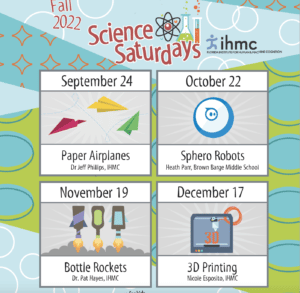
Florida Institute for Human and Machine Cognition’s Fall 2022 Science Saturday schedule.
Community sponsorships from Cox, Escambia Sheriff’s Office, Florida Blue Foundation, Gulf Power and Barnes Insurance make the Pensacola sessions possible.
Dr. Ursula Schwuttke is the director of educational outreach for both IHMC’s Pensacola and Ocala campuses. She surveys Science Saturday parents to gauge the impact of the sessions.
“We see that Science Saturdays are impactful for all families, but we see that we continue to make the most difference among families of more limited means — families who might not be able to offer their children the regular experience of hands-on science if our events weren’t free,” Schwuttke said.
Last school year, students from 27 Escambia and Santa Rosa elementary schools attended these weekend enrichment sessions at the Pensacola campus. Also:
- 83 percent of students attend more than one Science Saturday.
- 43 percent of attendees are female; 57 percent were male.
- 25 percent were third-graders; 19 percent were fourth-graders; 27 percent were fifth graders; and 29 percent were sixth graders.
All families report that the sessions boost their children’s scientific curiosity, motivation in science class, enjoyment of science and self-confidence in general. But families whose children qualify for free and reduced-price lunch uniformly report more impact on motivation and self-confidence in science class than other participating families.
Parents surveyed share that the diversity of programming and consistent high-quality are important, but the excitement their children share once they return from the workshops is what keeps them coming back.
“IHMC’s outreach effort provides a continuum of engaging hands-on science and technology events to give students the opportunity to nurture their interest, independent of family resources,” Schwuttke said.
SCIENCE SATURDAY FALL SCHEDULE
The schedule for Science Saturday for the Fall is complete. Please use this link to stay up to date on dates and topics for these sessions. And share the link with friends with children in grades 3-6 https://www.ihmc.us/life/science_saturdays/
Pensacola Sessions
Sept. 24: Jeff Phillips, Paper Airplanes.
Oct. 22: Heath Parr, Sphero Robots.
Nov. 19: Pat Hayes, Bottle Rockets.
Dec. 17: Nicole Esposito, 3D Printing.
Ocala Sessions
Sept. 10: Arash Mahyari, Electric Circuits.
Oct. 15: Manal Fakhoury, Reaction Time.
Nov. 12: Archna Bhatia, Harry Potter and Programming in Python.
Dec. 10: Erin Benavides, TBD.
IHMC is a not-for-profit research institute of the Florida University System where researchers pioneer science and technology aimed at leveraging and extending human capabilities. IHMC researchers and staff collaborate extensively with the government, industry and academia to help develop breakthrough technologies. IHMC research partners have included: DARPA, the National Science Foundation, NASA, Army, Navy, Air Force, National Institutes of Health, IBM, Microsoft, Honda, Boeing, Lockheed, and many others.
Dr. Kaleen Lavin on STEM-Talk talks about biology, exercise, and aging
Published 8.12.22
STEM-Talk episode 140 is now available featuring Dr. Kaleen Lavin, an IHMC researcher who investigates the molecular mechanisms by which the body adapts and reacts to stressors such as exercise, training, and aging.
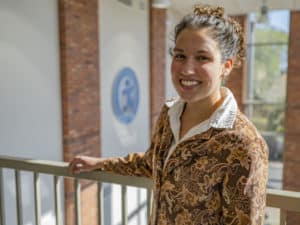
Dr. Kaleen Lavin is a research scientist at Florida IHMC. Photo credit: IHMC staff.
At IHMC, Lavin uses computational-biology techniques to understand and improve human health, resilience, and performance. STEM-Talks co-hosts Dr. Ken Ford and Dr. Dawn Kernagis interview Lavin about this work as well as her use of exercise as a countermeasure for a wide range of diseases, including neurodegenerative diseases such as Parkinson’s.
The conversation includes an in-depth talk with Lavin about her recent paper that took a comprehensive look at the current literature surrounding the molecular and cellular processes underlying exercise-induced benefits and adaptations in humans. Other topics discussed include:
- A 2017 study Lavin worked on that took people with Parkinson’s disease and ran them through a high-intensity exercise program and found that not only did the exercise program help people preserve some of their motor function, but also restored some function.
- Why the reduction in skeletal muscle mass with advancing age is such a serious issue.
- How the lifelong habit of exercise offers protection against “inflammaging,” which is the experience of chronic low-grade inflammation throughout the aging process.
- Lavin’s use of algorithms to assess the evidence of gene networks that link muscle building to gene expressions.
- Lavin’s recent research suggesting that exercising in the past leaves a molecular footprint, a kind of “muscle memory” that can come back to help people as they age, even if people haven’t kept up the habit of exercise.
- A project that Lavin and an IHMC colleague are undertaking to enhance a tool known as PLIER (pathway-level information extractor) to handle higher dimensions of data.
Lavin is a graduate of Georgetown University, where she earned a bachelor’s degree in biology. She also earned a master’s in sports nutrition and exercise science from Marywood University in Pennsylvania and a Ph.D. in human bioenergetics from Ball State University in Indiana.
STEM-Talk is a biweekly podcast that is part of IHMC’s outreach initiatives. IHMC is a not-for-profit research institute of the Florida University System where researchers pioneer science and technologies aimed at leveraging and extending human capabilities. For more information, visit ihmc.us.
IHMC receives grant to continue SquadBot research program
Published 8.8.22
The Florida Institute for Human and Machine Cognition robotics team lead by Dr. Robert Griffin secured a $3 million grant from the Office of Naval Research for SquadBot 2. The grant was approved in the summer of 2022.
The grant will allow the team to build upon the progress made on the first iteration of the SquadBot platform, named Nadia. A fully functional Nadia would be capable of working alongside and in place of soldiers in operations including building search, patrol, and bomb disposal.
“Nadia has the potential to shift the paradigm for urban operations and exploration, with the potential to save lives and reduce collateral damage,” Griffin says.
The SquadBot 2 project will work to improve the hardware platform, as well as enhance Nadia’s semi-autonomous behavior architecture to include persistence, particularly for entering structures and moving objects and obstacles. The work also will focus on developing advanced mobility algorithms focused on high-speed and multicontact locomotion, including approaches for bracing, crawling, and standing up after a fall.
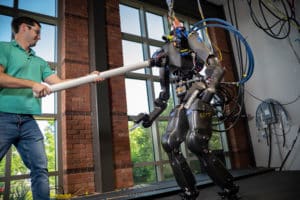
Success will be measured by execution speed and reliability compared to humans. The goal is the design of a robot able to remove debris from its path, capable of multicontact locomotion, and a high power-to-weight ratio to support fast, dynamic motions.
he key innovations of this project will be:
- Improved survivability of falls.
- Multicontact controls for building exploration.
- Persistent behaviors for building exploration.
The goal of the project is to create a high-performance humanoid robot platform with the range of motion approaching that of a human.
“We want to advance both the capabilities of humanoid robots and their speed of operation,” Griffin says. “The goal is to achieve human-level speeds so that the robots can keep pace with the tempo of real-world action.”
IHMC is a not-for-profit research institute of the Florida University System where researchers pioneer science and technology aimed at leveraging and extending human capabilities. IHMC researchers and staff collaborate extensively with the government, industry and academia to help develop breakthrough technologies. IHMC research partners have included: DARPA, the National Science Foundation, NASA, Army, Navy, Air Force, National Institutes of Health, IBM, Microsoft, Honda, Boeing, Lockheed, and many others.
STEM-Talk explores rapamycin and the biology of aging
Published 7.26.22
On episode 139 of STEM-Talk Dr. Matt Kaeberlein talks about the biology of aging, rapamycin, and what he has learned about slowing the aging process.
Kaeberlein is a professor of pathology at the University of Washington who is well-known for his investigations into the basic mechanisms of aging. Much of his research is focused on identifying interventions that promote healthspan and lifespan.
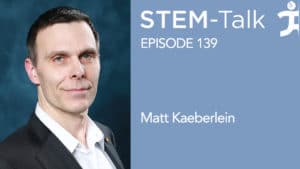
In a wide-ranging interview, STEM-Talk cohosts Dr. Ken Ford and Dr. Dawn Kernagis talk to Kaeberlein about longevity, his research into fasting and caloric restriction, and his recent investigations into rapamycin, the only known pharmacological agent to extend lifespan.
Kaeberlein’s 2017 paper that showed rapamycin may reduce the mortality of companion dogs landed on the front page of The New York Times and was picked up by news outlets around the world. Other topics that Ford and Kernagis discuss with Kaeberlein include:
- His attempts to uncover the molecular mechanism behind lifespan extension via calorie restriction.
- Research into how inhibiting mTOR has been shown to extend the lifespan of insects, rodents, and animals.
- His 2006 study that showed fasting extends lifespan in worms more than caloric restriction.
- An article he published last year that summarizes several of the most popular anti-aging diets and compares them with classical caloric restriction.
In addition to his work in the Kaeberlein Lab at the University of Washington, Kaeberlein is the co-director of the Nathan Shock Center of Excellence in the Basic Biology of Aging and the founding director of the Healthy Aging and Longevity Research Institute at the University of Washington.
He also is the founder and co-director of the Dog Aging Project.
STEM-Talk is a biweekly podcast that is part of IHMC’s outreach initiatives. IHMC is a not-for-profit research institute of the Florida University System where researchers pioneer science and technologies aimed at leveraging and extending human capabilities. For more information, visit ihmc.us.
Dr. Mark Lewis talks hypersonics in STEM-Talk Episode 138
Published 7.13.22
Failure is an important part of research.
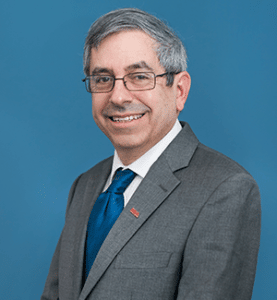
But in a risk-averse culture, the chance to learn from failure is hampering the development of some of the most important national defense tools needed for our arsenal, argues the expert guest on Episode 138 of STEM-Talk.
Dr. Mark Lewis is executive director of National Defense Industrial Association’s Emerging Technologies Institute (ETI), a nonpartisan think tank focused on technologies that are critical to the future of national defense.
Previously, Lewis was the Director of Defense Research & Engineering in the U.S. Department of Defense, overseeing technology modernization for all military services and DoD Agencies. He also served as the acting Deputy Undersecretary of Defense for Research & Engineering.
In this role he was the Pentagon’s senior-most scientist, providing management oversight and leadership for DARPA, the Missile Defense Agency, the Defense Innovation Unit, the Space Development Agency, federally funded research and development centers, and the DoD’s basic and applied research portfolio.
A self-described nerdy kid who was into model airplanes and rockets, Lewis traces his love of engineering to the Apollo program and the pivotal moment of watching Apollo 11.
“I remember watching Neil Armstrong walk on the moon. As a kid I was hanging on every Apollo mission, every Gemini mission before that,” Lewis says.
The highlights of his STEM-Talk include:
- A return to the test-fail mindset of the past. Lewis argues that a movement away from the acceptance of failure as part of the learning process is hindering the development of tools our defense arsenal needs to compete with Russia and China.

The X-51A Waverider, shown here under the wing of a B-52 Stratobomber is set to demonstrate hypersonic flight. Powered by a Pratt Whitney Rocketdyne SJY61 scramjet engine, it is designed to ride on its own shockwavem and accelerate to about Mach 6. (U.S. Air Force graphic)
One example he shares is the X-15 rocket plane, first test flown in 1959. The three X-15s built flew 199 times and set all manner of records in altitude, speed, etc. Mishaps and crashes didn’t end the program in part, Lewis argues, because failure was considered a vital part of the scientific process.
The X-51 hypersonic aircraft, by comparison, has flown four times since its initial fight in 2010 — with stretches of a year between test flights as investigators picked apart things that failed about previous tests. The long delays between test flights hindered the ability to learn more about what works and what doesn’t, he says.
The approach Lewis advocates: “Flying early, flying often, and when things break, we fly them again. When things fail, we learn quickly why they fail, and we recover.”
- The health of our defense infrastructure. The ETI’s Vital Signs report evaluates the readiness and health of the defense industrial base. The 2022 report gives it a D — an overall grade of 69, which is three points below last year’s grade.
The report authors assigned a failing grade in five areas, with one of the most troubling declines being in supply-chain performance. Another significant drop came in productive capacity and surge readiness.
- Hypersonics is the successor to stealth. Lewis argues hypersonics is a critical technology for the future of national defense. It is the logical follow-on from stealth, a technology that makes weapons effective because it makes them hard to see — and subsequently hard to stop.
Stealth technology has now been seen by the world, and our adversaries, who have had time to develop defenses to it and their own versions of it. While hypersonic flight itself is not new, Lewis says today we use the term to refer not only to speed, but also to maneuverability at that speed.
“In the biggest sense, hypersonics is about survivability,” Lewis says. “If I can be seen, the next logical step is that I travel in such a way at high speed and with unpredictable maneuverability that even though I can be seen, they won’t know exactly what I am or where I’m going and I’ll be difficult to stop.”
The “boom and bust” cycle of funding behind hypersonics has been frustrating, Lewis says, and in some cases stymied its development.
Russia has deployed hypersonic weapons in Ukraine. Lewis argues that their use is less about a military requirement in the current war in Ukraine per se, than it is about strategic messaging to NATO: That they have these weapons and are deploying them, and we do not.
- As Chief Scientist of the U.S. Air Force: Lewis got the job in 2004. It’s a position that dates to the Air Force’s earliest days in the late 1940s. By tradition the chief scientist comes from outside the Air Force to provide an outsider’s viewpoint. The Chief Scientist is empowered to be free-thinking – and free-speaking.
A predecessor in this position likened the job to being the court jester, Lewis says, and here is why: In medieval times, the king had a court of noblemen surrounding him. The jester was often the only person who could speak honestly to the king “without having his head lopped off. That’s the job of the chief scientist.” Lewis says.
He stayed in the role for four years, returning to academia in 2008.
- At the Pentagon. Lewis worked with Mike Griffin (STEM-Talk episodes 23and 134) in the Pentagon as the Director of Defense Research and Engineering. Modernization of the office was Griffin’s key priority — everything from space to cyber, AI to 5G communication, and of course, hypersonics.
- A Day Without Space study: In 2008, when Lewis was concluding his time as Chief Scientist of the Air Force, he launched a study that became known as the Day Without Space Study — essentially examining what warfare would be like without our space assets. What’s the answer? “Go watch ‘Saving Private Ryan.’ There is no situational awareness, limited communications. That’s what life would be like without space,” Lewis says.
- Directed Energy Technology. Historically there has been a sense that directed energy technology is hovering just over the horizon in the future, but Lewis argues we are “already there” in terms of its application.
“We’ve matured in our understanding of how we would use it.” It used to be the sense of directed energy’s application was replacing the gun with the laser. Rather, Lewis says, think about is as using the laser to do things that the gun can’t do.
- Investing in research funding. U.S. government funding for research and development fell by 12 percent between 2011 and 2016, while in the same time frame China increased its R&D investments by 56 percent.
Lewis notes, the United States is still the destination of choice for international students to come and study and stay.
“It has always been the American tradition for the best and brightest to come here and to stay here,” Lewis says. “And that’s still what we see.”
IHMC Summer Robotics Camp helps fuel a love of science for students
Published 7.5.22
If Jones Moore grows up to be an engineer, IHMC might be able to take a little credit.
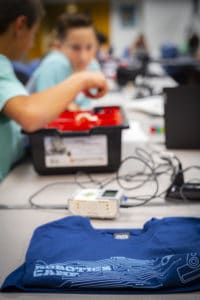
Jones, 12, has been to nearly every Science Saturday session Florida Institute for Human and Machine Cognition has hosted. This month, he spent his first week at Summer Robotics Camp as a rising eighth-grader. He was one of nearly 40 students who spent a week learning from the best at IHMC’s 2022 summer camp experience.
Jones says the best part of robotics camp was building robots and learning to code.
Robotics Camp is one of IHMC’s signature community outreach efforts for students, which also includes Science Saturdays, a school-year science enrichment program, and school-year field trips. Science Saturday is a series of 90-minute sessions on key topics including computer game design, robotics, roller coasters, butterflies, circuits and more. All are aimed at educating and inspiring the next generation of scientific minds.
Robotics Camp is one of the best times of year at IHMC. It is when the doors open wide — and the next generation of scientists walk through. Instructor Heath Parr, whose day job is as an Escambia County middle school teacher, led some 40 students in grades 8-10 through the basics of robotics, coding, and problem-solving.
Dr. Ursula Schwuttke is the director of educational outreach for both IHMC’s Pensacola and Ocala campuses. She organizes Robotics Camp and the Science Saturday series, which both are meant to spur a love of science in students so that the best and brightest minds are inspired to look for what’s next.
“Fun science gives kids the ability to discover their interest and ability in science, and to develop self-confidence,” says Schwuttke. “Opportunity is vitally important for kids. Without the opportunity to discover their interest, they can’t know that it’s something they should pursue.”
While assembling and programming the robots is of course the fun part, a highlight of camp is the chance to meet and mingle with researchers on the IHMC team. This year, Senior Research Scientist Dr. Jeff Phillips, Research Scientist Dr. Gwen Bryan, and Research Associates Duncan Calvert, Nicole Esposito and Josh Farina all took time out of their schedules to visit with campers, have lunch and share information on their current research, and how they launched their own science careers.
They made a big impression on Jones.
“I think since they had professionals on hand it helped that you could talk to them and learn new things,” said the Pensacola middle schooler.
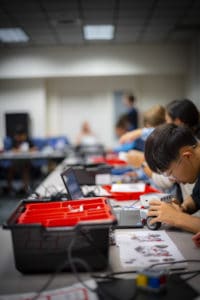
Robotics Camp is sponsored by Cox, the Escambia Sheriff’s Office, Barnes Insurance, and Florida Blue. Their support made camp possible and allowed us to include students from the Educational Talent Search Program at Pensacola State College and Pace Center for Girls, to help create a pipeline for IHMC to share what we love about science with students in every corner of the community.
Serving the whole community is an important component of IHMC’s outreach. Schwuttke surveys Science Saturday parents to try to gauge the impact of the sessions. All families report that the sessions boost their children’s scientific curiosity, motivation in science class, enjoyment of science and self-confidence in general. But families whose children qualify for free and reduced-price lunch uniformly report more impact on motivation and self-confidence in science class than other participating families.
“We see that Science Saturdays are impactful for all families, but we see that we continue to make the most difference among families of more limited means — families who might not be able to offer their children the regular experience of hands-on science if our events weren’t free,” Schwuttke said.
Science is about pushing the boundaries of what is known to explore the depths of what is possible. IHMC is proud to have been a small part of that for kids like Jones Moore, and all of the students who have been part of our education outreach efforts. We can’t wait to resume Science Saturdays in the fall — and we hope many more young science enthusiasts out there will join us.
Visit https://www.ihmc.us/life/science_saturdays/ for the most recent updates.
IHMC is a not-for-profit research institute of the Florida University System where researchers pioneer science and technology aimed at leveraging and extending human capabilities. IHMC researchers and staff collaborate extensively with the government, industry and academia to help develop breakthrough technologies. IHMC research partners have included: DARPA, the National Science Foundation, NASA, Army, Navy, Air Force, National Institutes of Health, IBM, Microsoft, Honda, Boeing, Lockheed, and many others.
Greg Potter talks sleep quality, influences in STEM-Talk episode 137
Published 6.17.22
Sleep is a precious commodity — especially if you struggle with it. Nutrition, exercise, lifestyle, and circadian biology are an interrelated web with tremendous influence on the quality of our sleep.
In the latest episode of STEM-Talk (episode 137), we pick up a conversation with Dr. Greg Potter in an interview where he explores topics including insomnia, sleep apnea, time-restricted eating, exercise, nutrition, and supplementation. The first part of our interview (STEM-Talk episode 136) with Potter brought a deep-dive into circadian biology, sleep, diet, and metabolism.
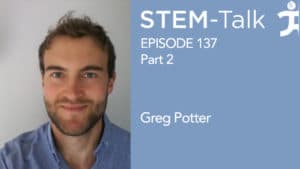
Visit https://www.ihmc.us/stemtalk/episode-137/ to listen to the full conversation with Greg Potter.
Potter ‘s work has been featured in the BBC World Service, the Washington Post, Reuters and other scientific journals and news outlets. Some of Potter’s conversation with IHMC’s CEO and founder Dr. Ken Ford in episode 137 touches on whether there is a biological basis for the idea of chronotypes, a concept that some people are better suited to an earlier or later sleep schedule.
So, is there such a thing — biologically — as morning larks and night owls?
“I think the chronotype does exist in both human and non-human animals” but it is hard to work out the influence of genetics and environment.,” says Potter, who cites a study about the impact of camping on early birds and night owls.
In this study, once folks were camping, their biological clocks synced very strongly with the environmental clock — and the difference between the early and late risers shrank noticeably. The late risers’ biological clocks moved back to more closely match the early risers, who were in general already closer to the environmental day-night cues from nature.
Ford and Potter also talk about chrononutrition, the relationship between a person’s nutrition and their body clock. What you eat influences the function of your body clock, because your clock optimizes your body for certain processes at certain times of day. The question is whether you can use that understanding to optimize your diet.
Some key terms for this conversation: Time-restricted eating. (restricting eating to a period of 12 hours or less each day). Intermittent fasting is periodic use of a fast of 24 hours or longer.
Potter’s key takeaways:
- “If we think about the day beginning when you wake up, you should wait before you consume anything other than water. At least an hour, especially if you awaken in the “biological night” because you likely have a good deal of melatonin circulating in your body.
- Time-restricted eating using a 6- to 12-hour “eating window” is a good way to go for most people. Base your “eating window” on what your goals are. If you currently eat over a 14-hour period, don’t jump straight to an 8-hour eating window. Start with a 12-hour window, then back it down. If your goal is to lose weight, using an 8-hour window might be preferable.
- In general, a shorter eating window is well-suited to the ketogenic diet. The longer fasting period is likely to accelerate the ketosis period. So, if you are just starting on the ketogenic diet, you might want to implement time-restricted eating to make it more straightforward.
- Wait maybe 3 to 6 hours between meals. If you eat more frequently than that, if you are interested in your body composition, you might not be able to maximally stimulate muscle tissue synthesis over time.
- Front-loading intakes matters. Studies have shown that front-loading — eating a big breakfast followed by smaller meals as the day goes on — can help weight loss and blood sugar control.
- When you exercise also matters. If you exercise in the afternoon, you don’t need to worry so much about front-loading because of the influence exercise has on metabolism.
- Distribute your protein intake relatively evenly throughout the day. A lot of people have loads of protein at dinner and little at breakfast. With respect to body composition, that’s not ideal. At each meal, you need enough protein to maximally stimulate muscle protein synthesis. And at the end of the day, stop eating two hours before bedtime.
There is a school of thought that we should re-engineer our lifestyles to better mimic certain aspects of our distant ancestors to protect ourselves from chronic diseases and boost our energy levels. While that may not be practical in total, Potter says there are aspects of our ancient ancestors’ lives we ought to emulate.
- Eat food that is minimally processed and locally available.
- Build physical activity around eating. Studies show a 20-minute walk after eating improves blood sugar response.
- Spend enough time outdoors in daylight and keep the sleeping area dark.
- These people shared everything – food, caregiving responsibilities in a fairly un-hierarchical life. Community and connection is important not only for our biological, but also our social well-being.
Listen to the full conversation here.
Dr. Niranjan Suri named IHMC associate director
Published 6.13.22
Dr. Niranjan Suri has been named an associate director at Florida Institute for Human and Machine Cognition. Suri is an IHMC Senior Research Scientist and Associate for Research for the Information Sciences Division at the U.S. Army Research Laboratory.
Suri has been part of the IHMC family since 1994 and was part of its beginnings at the University of West Florida. It is a fitting chapter in the career of Suri, who first connected with IHMC founder Dr. Ken Ford as a UWF student and teaching assistant back in the early 1990s.

“I have known Niranjan since he was a student long ago and have enjoyed watching his development as a colleague and successful senior research scientist at IHMC,” Ford says. “He has always been a joy to work with and a team player. He has contributed to IHMC in many ways and now, while continuing his important research, he steps into a leadership role.”
“One of the best parts of being with the IHMC team is to be able to work with a diverse, interdisciplinary group of people, with expertise in a wide variety of subject matters,” Suri says. “I think another excellent attribute at IHMC is that everyone is trying to be helpful – so that all of us can succeed in our research.”
Suri’s recent research focuses on Agile Computing, which supports the discovery, management, and exploitation of resources and information in highly dynamic networked environments. His other research interests include Distributed Systems, Networking, Communications Protocols, and Internet of Things.
He recalls that his first IHMC-related job — back when IHMC was in a small section of Building 79, then the Computer Science department — was for Dr. Alberto Canas, IHMC Associate Director and Senior Research Scientist, for a project called Quorum.
“(Quorum’s) goal was to enable school kids in South and Central America to collaborate and exchange information,” Suri says. “I was also a Teaching Assistant for Dr. Ford for his Introduction to AI course. ”
While working on his master’s degree at UWF, Suri started focusing more on his own research and working with others, like Dr. Jeffrey Bradshaw, on Software Agents. They first started working with the Defense Advanced Research Projects Agency (DARPA), and then branched out to do more work with the U.S. Army, Navy/Marine Corps, and Air Force.
“My research has since mostly evolved to focus on Distributed Systems, Intelligent Networking, and Communications, and the area we more broadly label Agile Computing,” Suri says.
In his work with the Army Research Lab, Suri works with a number of North Atlantic Treaty Organization (NATO) Research Task Groups. He also supports the Internet of Battlefield Things (IoBT) program at the Army Research Lab and was responsible for setting up the Distributed Virtual Proving Ground (DVPG), an experimental testbed that connects multiple university and government sites together for joint experimentation.
He has taught undergraduate and graduate courses in Computer Science at UWF for over 10 years and currently mentors two students in the joint IHMC-UWF Intelligent Systems and Robotics Ph.D. program.
He has been a principal investigator of numerous research projects sponsored by the U.S. Army Research Laboratory, the U.S. Air Force Research Laboratory, the Defense Advanced Research Projects Agency, the Office of Naval Research, and the National Science Foundation.
Suri has authored or co-authored more than 200 papers, has been on the technical program committees of several international conferences, and has been a reviewer for NSF as well as several international journals.
While assuming a leadership role at IHMC, Suri will continue his research work. He hopes to continue the traditions that have made IHMC a compelling and unique place to work.
“Compared to other organizations, a great part of IHMC is the freedom for researchers to focus on their work with minimal overhead and interference,” Suri says. “Leadership is there to help all the researchers succeed, not to get in their way. As an Associate Director, I hope to continue that trend.”
IHMC is a not-for-profit research institute of the Florida University System where researchers pioneer science and technology aimed at leveraging and extending human capabilities. IHMC researchers and staff collaborate extensively with the government, industry and academia to help develop breakthrough technologies. IHMC research partners have included: DARPA, the National Science Foundation, NASA, Army, Navy, Air Force, National Institutes of Health, IBM, Microsoft, Honda, Boeing, Lockheed, and many others.
Carol Carlan joins IHMC as director of philanthropy
Published 5.31.22
Carol Carlan has joined the Florida Institute for Human and Machine Cognition as director of philanthropy.
Carlan, who most recently had been president of Ascension Sacred Heart Foundation, brings a wealth of experience, knowledge, and a deep connection to the community to the new role.

Carol Carlan joins IHMC as Director of Philanthropy.
“IHMC is a jewel of Pensacola. The team there has built an international reputation for excellence in the fields of artificial intelligence and robotics,” Carlan said. “The healthspan, resilience, and performance research is on the same trajectory. The chance to be a part of IHMC, and to tell its story, was a thrilling opportunity. I can’t wait to get started.”
As director of philanthropy, she will share IHMC’s story and help to grow national and communitywide support for its work.
“Carol’s passion for improving the community is rivaled only by her commitment to the value of research and education as a tool to build not only an individual’s potential, but also a community’s future prospects,” said IHMC CEO and Founder Ken Ford. “We are fortunate to add an advocate of her skill and expertise on our team.”
“As IHMC has grown, so too have the opportunities for the community to support our work grown,” Ford said. “Carol was IHMC’s inaugural board chair. She has been with us from our beginnings and is uniquely qualified to share the story of how the footprint of our work has evolved over time.”
Carol is a longtime community leader and successful business executive. Her banking career spanned more than 35 years as the first female president of a large regional bank, and for the past 10 years as the President of the Ascension Sacred Heart Foundation. She led one of the largest capital campaigns in the region which resulted in a new children’s hospital and expansion of children’s services in the Destin market. Under her leadership the foundation generated more than $62 million dollars of philanthropic dollars during her tenure.
As President of Carlan Consulting, a leadership development company, she is a founding member of the John Maxwell Team, a global training organization for leaders with more than 50,000 members worldwide.
As a community leader she has served on more than 35 not-for-profit organizations during her career and is an Emeritus member of the Pensacola State Foundation, a founding member of The Pace Center of Girls Escambia/Santa Rosa, long time member of the Pace State Board of Trustees, Inaugural Chair of the Institute of Human and Machine Cognition (IHMC), 125th Chair of the Greater Pensacola Chamber and is currently the longest serving Trustee of Pensacola State College Board of Trustees.
She has received numerous awards and recognition for her work to name just a few.
Pensacola Chamber PACE Awards recognized her as the Spirit of Pensacola and Business Leader of the Year, she was recognized by her peers of Leadership Pensacola with the Blue Angel Leadership Award, a participant of the Leadership Florida Class of XXX, recognized for her many years of work as a Trustee of the Pace Center for Girls State Board of Trustees she was awarded the 25th anniversary Pioneer Award, the regional Pinnacle Award for her many years of service to state and local organizations.
IHMC is a not-for-profit research institute of the Florida University System where researchers pioneer science and technology aimed at leveraging and extending human capabilities. IHMC researchers and staff collaborate extensively with the government, industry, and academia to help develop breakthrough technologies. IHMC research partners have included: DARPA, the National Science Foundation, NASA, Army, Navy, Air Force, National Institutes of Health, IBM, Microsoft, Honda, Boeing, Lockheed, and many others.
Greg Potter STEM-Talk tracks power of body’s “master clock”
Published 5.17.22
Your body’s “master clock” evolved to help keep you alive and safe. And when it’s disrupted, it doesn’t take long at all for the negative impacts of that circadian rhythm shift to be felt in your health and well-being.
The latest episode of STEM-Talk (episode 136) brings a deep-dive into the intricate connections between your body’s circadian biology, sleep, diet, and metabolism, with Dr. Greg Potter.
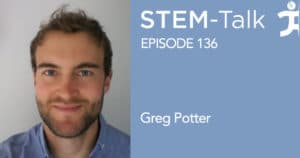
Dr. Greg Potter is the guest on Episode 136 of STEM-Talk.
Potter gained attention in the U.S. and Europe for his research into the importance of biological rhythms and sleep and how they affect people’s lives. His work has been featured in the BBC World Service, the Washington Post, Reuters and other scientific journals and news outlets.
He also co-founded Resilient Nutrition in 2020, a company that leverages science to produce foods and supplements geared toward helping people feel and perform better. He earned undergraduate and master’s degrees in exercise science from Loughborough University in England before heading off to the University of Leeds for his Ph.D.
During his STEM-Talk interview, Potter talks about a paper he published in Endocrine Reviews in 2016 on circadian rhythm and sleep disruption. Some of his key points:
Organisms evolve in the presence of relatively predictable changes in the environment: light, temperature, food availability. Think of these as an environmental clock, he says. To thrive in these environments, people evolved biological rhythms to cope:
- Ultradian rhythms repeat cyclically throughout a 24-hour period (heartbeat, blinking, appetite, circulation, etc.).
- Circadian rhythms recur every 20-30 hours (core body temperature, sleep-wake cycle). These persist even when someone doesn’t have time cues.
- Infradian rhythms, the slowest of these, last longer than one day, such as the menstrual cycle.
The purpose of these rhythms is to maximize our body’s performance of certain functions and adapt to changes in the environment, Potter said. Think of it as a master clock in your brain (circadian clock) and peripheral clocks.
“Why is it a problem if we disrupt our clock? Most if not all aspects of our biology suffer and many of us have felt this during jetlag,” he says.
Some experiments have shown that if you assign otherwise healthy people to a 28-hour day, after three of those days, they begin to show signs of pre-diabetes because their eat-sleep cycle is so disrupted, Potter said. This misalignment increases blood pressure and increases inflammatory markers.
Blood sugar regulation is one of these peripheral clocks. Studies show people’s glucose tolerance is 17 percent lower in the biological evening than it is the biological morning. Metanalysis has shown that blood sugar responses therefore are worse when you eat between 8 p.m. and 4 a.m.
Humans now face dealing with the “social clock”, which our evolutionary ancestors did not have, but that industrialization made this clock more prominent.
For example, Potter said, we now spend 88 percent of our days indoors. Indoor lighting is lower intensity that natural light – 30 times less intense than natural sunlight.
“We’ve also engineered physical activity out of our lives,” Potter says. We don’t have to be active to get our food. Some 86 percent of American don’t meet basic physical activity requirements, Potter says. Now in the digital age, we can work in distributed teams across multiple time zones and that can contribute to disruption.
All of that combines for a lot of change – and evolutionarily speaking — our bodies haven’t caught up to all those changes.
“Our body’s clock still follows the sun despite whatever the social clock does, despite whatever time changes are enforce,” Potter said.
Listen to the whole talk here, and look for part two to cover topics ranging from insomnia, sleep apnea, time-restricted eating, exercise, and nutrition.
Dr. Duane Mitchell talks immunotherapy cancer treatment
Published 5.5.22
While immunotherapy is a relatively recent – and promising – cancer treatment, the underpinning of it goes back more than 100 years.
That’s according to IHMC Evening Lecture guest Dr. Duane Mitchell, whose April 2022 talk focused on immunotherapy for treatment of cancers, including the aggressive brain cancer glioblastoma.
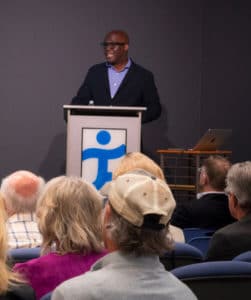
Dr. Duane Mitchell of the University of Florida speaks at an IHMC Evening Lecture in April 2022.
Mitchell is an expert in the development of innovative immunotherapy treatments for children and adults with malignant brain tumors. He is the Phyllis Kottler Friedman Professor in the Department of Neurosurgery. He serves as Director of the University of Florida Clinical Translational Science Institute and Co-Director of the Preston A. Wells, Jr. Center for Brain Tumor Therapy.
He has pioneered therapies that have been translated into first-in-human clinical trials and multi-center phase 2 studies. His cancer research has been funded by the National Institutes of Health since 2009. In his talk, he reviewed advances in immunotherapy treatments for more than 15 types of cancer including prostate, lung, breast, and melanoma.
Immunotherapy is a field that has grown significantly in the last 10 years. Historically, the concept that the immune system might recognize and try to fight cancer dates back at least to the late 1800s. As a treatment, it began gaining widespread traction in the mid-1990s.
That 100-year-old insight can be traced to a patient who had a surgical resection and then a subsequent bacterial infection. In treatment of the bacterial infection, the immune cells were spurred to respond to fight the cancer cells as well, and the patient experienced remission of the remaining cancer, Mitchell said. That began a series of experiments by Dr. William Coley, who injected patients with bacteria to try to induce this immunologic response. A form of this treatment method is used to this day, for example, in some superficial bladder cancers, Mitchell said.
The immune system sends signals either to health and repair, or fight and kill. Cancer in a sense sends the body mixed signals, Mitchell said. There are abnormalities the body can recognize, but there are also proteins that do not trigger that response. Often the result is the body’s response is to “feed, grow, and heal” the cancer rather than to “kill” the malignant cells, Mitchell said.
The immune system has both activating and regulatory signals, which tell the body to attack or not. Mitchell said, in cancer, the activating signals are being overridden by these regulatory “checkpoint” signals. The ability to block these signals has been a huge shift in treatment, Mitchell says.
These have had dramatic effect in melanoma, non-small-cell lung cancer and 15 other cancers.
“This has been a revolution of a 100-year-old concept… it’s quite a dramatic shift,” he said.
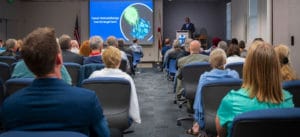
The audience at the IHMC Evening Lecture series in Pensacola in April 2022.
This has manifested in four broad types of treatment:
- Vaccine to try to stimulate the immunologic response. Loading dendritic cells with antigens or delivering the antigen into the patient so that their own dendritic cells pick up the antigen and engage the immune system.
- Adoptive cellular therapy. This therapy extracts T-cells to grow them in large numbers and then deliver the cells back to the patient.
- Immune checkpoint inhibitors. Turning these off, freeing the body’s own immune system to respond.
- Viruses modified to kill tumor cells. The response to these viruses can also trigger the immune system to attack the tumor cells.
Immunotherapy has created an extension of durable benefits and survival for some patients, but not all. Why? That’s a question Mitchell and his team, and others, are continuing to research.
The body’s microbiome has an influence on response to immunotherapy, Mitchell said. And while chemotherapy typically represses the patient’s immune system, in some cases using chemo and immunotherapy together has been shown to be quite effective, especially in certain types of breast cancers.
Brain cancer is one of the cancers that is the hardest to treat, and this is an area where Mitchell’s team at UF is actively working, as well as understanding the durability of the immune response.
IHMC is a not-for-profit research institute of the Florida University System where researchers pioneer science and technologies aimed at leveraging and extending human capabilities. For more information, visit ihmc.us.
Triumph grant helps seed IHMC’s vision for human performance complex
Published 4.15.22
It’s not enough for elite warfighters to have a high level of physical fitness and cognitive ability in today’s military. They also have to be resilient. While the tools and weapons of today’s warfighters have evolved dramatically over the past few decades, the military’s understanding of the biological processes that govern human performance and resilience has not evolved to the same level.
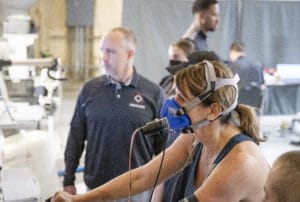
The planned IHMC human performance research complex will be a home for IHMC’s HRP work.
For years now, Ken Ford, IHMC’s co-founder and CEO, has envisioned a research team focused on finding innovative ways to extend the capabilities and resilience of high-performing humans who routinely operate in extreme conditions and environments.
“One of the reasons we’re interested in extreme environments is that high performing humans often fail in these environments, and you can learn a lot by studying failure mode,” said Ford. “If you take a high performing human, like an astronaut, and put them in space, things can go bad very quickly. That’s just as true under the ocean and it’s just as true in a fighter jet.”
Ford made this point during a 2018 interview with Florida Trend following a $1 million donation from Pensacola philanthropists and entrepreneurs Quint and Rishy Studer, who bought into the vision of an expanded role for IHMC to play in human performance.
The effort received another boost last year when Triumph Gulf Coast awarded IHMC $6 million to help seed a Healthspan, Resilience, and Performance team and complex. The new complex is being fast-tracked and will establish a one-of-a-kind capstone for research and development. The multimillion dollar facility will expand IHMC’s downtown campus into three main buildings.
In addition to creating a one-of-kind facility for human-performance research, the complex will bolster the regional economy through new funding in federal and industry-sponsored research.
“We will be collaborating closely with regional institutions and organizations that share an interest in human health span and performance,” said Julie Sheppard, IHMC’s Executive Vice President and Chief Legal Counsel, who helped spearhead the Triumph proposal. “It’s our belief that these collaborations will lead to innovative spinoff opportunities not only for IHMC, but also will create opportunities for local technology transfer partners.”
IHMC has always focused on the development of science and technology to leverage and extend human performance, particularly cognition and then locomotion, said Ford. “Originally our work was strictly cognitive because IHMC was started mostly by artificial intelligence people. Then we moved to broaden that to include robotics. And then next we started looking at not just cognitive performance, but also physical performance, exoskeletons and several other related fields.”
About 10 years ago, Ford said he and others at the institute become more interested in broadening that work. “So now, rather than having only two approaches to elevating human performance, we are in the early stages of expanding our research into the biological means to do that.”
The Triumph funds, secured from BP in a legal settlement following the 2010 Deepwater Horizon Oil Spill, have been set aside to stimulate economic development in eight Northwest Florida counties that were significantly impacted by the spill. Ford, as well as the Triumph board, believe the HRP complex will have a transformational economic impact on Northwest Florida.
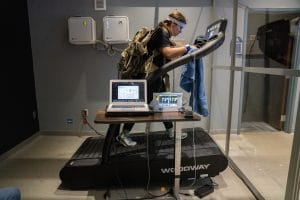
Human performance research at IHMC will find a new home in a planned facility slated to open in early 2024.
IHMC currently receives significant federal government funding for its research, particularly as it applies to elite warfighters, astronauts and special-operations forces. The HRP complex will permit IHMC to grow its research portfolio in this emerging area. In addition to its collaborations with the Department of Defense, NASA and other federal departments and agencies, the HRP complex will bolster the regional economy through new collaborations and funding in federal and industry-sponsored research that focuses on molecular and genomic science; biochemistry; cellular and tissue biology; physiology; biomechanics; biomedical engineering; regenerative medicine; neuroscience; rehabilitation; clinical trials; and machine learning and computational biology.
The HRP complex is one of the reasons that Dr. Marcas Bamman joined IHMC last year.
“What we’re talking about is a rare, one-of-a-kind research opportunity,” said Bamman, an internationally recognized researcher known for his scientific contributions to the biology of human skeletal muscle and medical rehabilitation. Ford recruited Bamman to join IHMC’s biologically motivated team and become one of the ground-floor architects of the new effort.
As the founder and former director of the University of Alabama at Birmingham Center for Exercise Medicine, Bamman and the UAB center have been recognized as world leaders in the biological mechanisms underlying exercise-induced adaptations and their clinical utility in disease prevention and treatment as well as rehabilitation.
“What drew me, in addition to the talent, leadership and vision of IHMC, is the unique opportunity to establish a capstone research complex for advancing knowledge in human performance and resilience in a truly interdisciplinary manner,” said Bamman. “The idea is to bring together all the key focus areas that have not necessarily been co-located before. In other words, we will be bringing together everything from clinical assessment to rehabilitation to clinical trials to molecular and biological analysis. Then we will be able to use computational biology to look at people’s biological responses to various treatments in a very powerful way.”
What particularly excites Bamman is that the complex will allow him and others to do research from molecule to man.
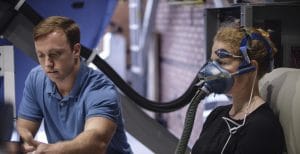
Research into human performance soon will have a new home as work is set to begin on $20 million facility on IHMC’s Pensacola campus.
“One of the unique things we have here at IHMC, which will be substantially advanced by the new complex, is the ability to integrate researchers who specialize in human performance and resilience with computational scientists, artificial intelligence and even robotics. IHMC’s exoskeleton-based work has a high degree of relevance for military operators as well as rehabilitation sciences. And like I said, to be able to do all this with one large team that leads research from molecule to man, or molecule to the whole human, is pretty remarkable.”
Research programs with this scope typically rely on bringing together the expertise and facilities of several institutes from around the country or world, said Bamman.
“In the new HRP complex, we will be able to walk across the hall and tap into the expertise of people outside of our particular focus area. It will be an exciting environment where we as scientists can all learn from each other.”
Another key player in the development of the HRP complex is IHMC’s Chief Science Officer Tim Broderick. Broderick is a surgeon and biomedical engineer who has been a pioneer in laparoscopic, robotic and telerobotic surgery.
Prior to joining IHMC in 2019, Broderick was an academic surgeon and a DARPA program manager. During his years at DARPA, he conceived and established five high-impact biotechnology projects that included revolutionary programs focused on precision diagnosis and treatment of military-relevant diseases and injuries. Broderick also has led multiple ground, flight and undersea-based biomedical research projects.
Broderick and IHMC recently worked on a project that is part of a DARPA program known as the Measuring Biological Aptitude program, or MBA. It’s an example of the type of project that will become part of new complex’s impressive portfolio.
The crux of the MBA program is correlating the externally observable physical, behavioral, and cognitive features and traits of specialized operators and pilots with measurable elements of their biology to understand and ultimately anticipate how they will perform in various situations over time.
“This project allowed us to work on developing a disruptive training platform that integrates revolutionary molecular and metabolic analysis with some advanced predictive models. These models will use the latest approaches in machine learning and artificial intelligence utilizing novel real-time sensors that will allow us to measure the performance of a special forces operator or pilot.”
Some of the projects in IHMC’s pipeline that tap into the institute’s new multi-disciplinary expertise in human performance and resilience include:
• Evaluating Potential Benefits of Intranasal Oxytocin on Undersea Operator Training and Performance: Naval Special Warfare (NSW) operators are exposed to a variety of extreme environmental conditions and intense physical demands. In addition to beathing high-pressure gases during prolonged cold-water immersions, inadequate recovery from sustained physical exertion underwater can negatively impact individual and team performance. The sponsors are looking for biotechnologies that could mitigate the effects of cold as well as support physical recovery, which would represent a significant unmet need for the NSW operational community. A possible mitigant is oxytocin, which has a wide range of actions both locally in the brain and peripherally in the body as well as in skeletal muscle. These peripheral effects can be mediated by classic ligand-receptor activation given the abundant expression of the oxytocin receptor in peripheral tissues. The IHMC project is looking at the administration of exogenous oxytocin, an approved FDA Investigational New Drug that has been shown as an easy and safe method to increase circulating oxytocin concentrations that may augment actions on peripheral tissues. It is an easily administered, adjunctive biological therapy that has the potential to improve recovery, performance and resilience of warfighters.
• Strategies to Augment Ketosis: Assessment of Prophylactic Ketone Administration on Concussive Injury in the U.S. Army Basic Airborne Course: IHMC researchers are conducting a novel trial designed to assess the efficacy of ketone ester supplementation during U.S. Army Basic Airborne Course training as a prophylactic against detrimental cognitive outcomes that soldiers sometimes experience following mild traumatic brain injury (mTBI). The study is exploring whether a metabolically supported ketone-fueled brain is more protected from neurotrauma. As part of the trial, researchers are examining the pre-jump prophylactic potential of ketone ester supplementation to attenuate closed head injury-induced changes in cognitive performance. Researchers also are looking at the potential of ketone esters to alter blood and urine-based protein, molecular, metabolic and lipid profiles that are impacted by closed head injury during jump training. Another aspect of the study is the development of a multidimensional predictive model of mTBI risk among basic airborne training course participants.
Dr. Morley Stone, IHMC’s Chief Strategic Partnership Officer, says projects like this build upon the institute’s multidisciplinary experience. IHMC already has extensive experience with traumatic brain injury research as well as a long history of productive and collaborative research for the Department of Defense.
“In addition to our reputation and heritage of impactful research, IHMC’s internationally known researchers along with the new HRP complex will give us the infrastructure and experience capable of accepting and executing a wide range of grants and contracts related to human performance and resilience,” Stone said.
To accommodate this expansion into human-performance research, IHMC is hiring people with specialized expertise (see profiles pages 5 and 6). Dr. Kaleen Lavin is a physiologist and molecular biologist who was a postdoc with Bamman at UAB for three years before recently joining IHMC. Her specialties are in human physiology and computational biology.
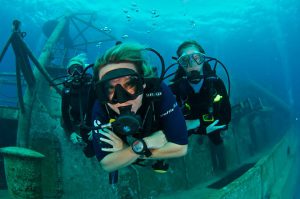 “What I do is provide a kind of molecular perspective on how a person’s biology works. I incorporate a lot of computational work that helps us understand why people respond differently to exercise and other stressors, and why some people are more resilient than others when exposed to the exact same type of stress.”
“What I do is provide a kind of molecular perspective on how a person’s biology works. I incorporate a lot of computational work that helps us understand why people respond differently to exercise and other stressors, and why some people are more resilient than others when exposed to the exact same type of stress.”
To do this, Lavin is looking at a person’s biology at a very fine molecular level. She’s looking at a person’s gene expression and different proteins and how they change from person to person with exposure to stress.
“It requires a computational approach where the datasets are enormous,” said Lavin. “That’s how we are able to see the fine changes that we do see. But you can’t look at these datasets in a spreadsheet like you can with other types of data. Here, we’re talking about several tens of thousands of rows of data. Because of the complexity of the work we’re doing, it will significantly improve the speed and accuracy of our work if we’re able to have it become more automated with AI.”
Lavin is already working with some of the AI scientists at IHMC on innovative ways to analyze data and write programs that will advance how researchers can interpret the complex sets of molecular data that she pulls together. As Bamman points out, “There are just not that many research environments where you can walk across the hallway and do that.”
Bamman says the work that Lavin is doing is a great example of the kind of research IHMC will be able to do through the HRP complex.
“We want to be able to take blood and saliva samples and map all the molecular responses that can occur as a result of any number of things that can change a person’s physiology and how it relates to their physical and cognitive performance.”
For example, Bamman said, take two military operators who are performing some sort of strenuous task in an extreme environment like high altitude. There would be common responses between the two at the molecular level. But there would also be several differences between the two. So how that high-altitude stress impacts the two individuals differently at the molecular and performance level is what we’re trying to understand. “Kaleen is working with our AI scientists to map all of these similarities and differences,” said Bamman.
That’s why Lavin is so excited about the human performance complex.
“I love having the ability to ask the kind of questions that Marcas and the other researchers are talking about and having the resources around me to answer them in the most rigorous way possible by working with people who are top experts in their fields, fields that are quite different than mine. I mean, there’s no better way to do this kind of research. That’s what brought me to IHMC.”
Ford is working to fast-track the HRP complex and have the doors open in 2024.
“There is so much we can do once we get the HRP facility up and running. We will have an environmental chamber that we can use as a stress environment. We will have flight simulators and labs and the kind of advanced technology that will help rigorously test and measure physical and cognitive performances of warfighters, astronauts, pilots and other high-performing humans. I envision the complex being a place where researchers can, with very little bureaucracy, have access to a wide range of expertise to bear on a problem.”
Ford says that in terms of IHMC future, he anticipates about a third of the work at the institute will be in human performance and about a third in AI and another third in robotics.
“The vision for the human performance complex is to have a place where you can combine the computational expertise, the biological expertise and the translational expertise all in one place so that we can, as Marcas says, do research from molecule to man,” said Ford. “This facility really will be one-of-a-kind.”
IHMC is a not-for-profit research institute of the Florida University System where researchers pioneer science and technologies aimed at leveraging and extending human capabilities. For more information, visit ihmc.us.
Dr. Mark Williams part of Evening Lecture series return
Published 3.30.22
Can you spot the future superstar soccer player in this crowd?

If your choice is anyone other than short, slight boy on the second row, second from the right, bad news: You missed Lionel Messi.
Dr. Mark Williams, Senior Research Scientist at IHMC, has made it his business to learn what makes an elite athlete like Messi the best. His March 2022 talk as part of the IHMC’s popular Evening Lecture Series shared some of the common traits of the greats. The Evening Lecture Series has returned to both the Pensacola and Ocala IHMC campuses. To keep up with the latest schedule of talks, visit https://www.ihmc.us/life/evening_lectures/
Environment, birth order, adaptations, learning, and practice are all factors that build sports expertise, Williams said.
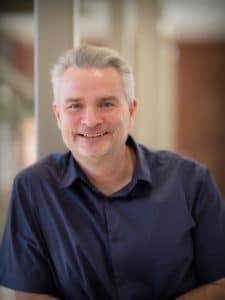
Dr. Mark Williams
So, too, is there room for science to explore the psychological and cognitive differences sports experts possess when compared to sub-experts in their field, Williams said.
For example, as soccer players in the Premier League Academy system age up, game intelligence skills become more key than the strictly physical gifts that can set them apart from their peers early on.
Elite athletes have some common psychological characteristics. They:
- Pick up more visual cues from their opponents’ bodies. That’s because their hours of practice have created a rich library of cues and scenarios about what might happen next.
- Have superior pattern recognition.
- Have more effective visual search behaviors. That’s reflected in something called the “Quiet Eye” phenomenon. That’s the period of final visual fixation before the performance of the final phase of movement — when it really counts, what your eye lasers in on before you commit the physical movement.
- Have greater robustness under pressure (fixate centrally and use peripheral vision to gather info).
What also begins to matter more is what Williams calls, the psychology of excellence. Skills like motivation, mental toughness, perfectionism, resilience, and coping become crucial components for an expert, he says.
And while yes, the popular notion that it takes 10,000 hours of practice — at least — to be great at something has scientific merit, expertise is also developed by how those hours are spent. Experts, Williams shared, avoid arrested development by engaging in deliberate practice: Practice with a purpose.
Experts devote more time to practicing weaker skills, exhibit more self-reflection, use more physical and mental effort during practice, and may find practice less enjoyable.
Understanding how expertise is built can improve coaching and teaching strategies.
The challenge of coaching, for example, is “what’s the least amount feedback the learner needs to sustain change in performance?” Williams says. “To infer that learning takes place, I have to see that change in performance contributes to future practices.”
What we learn about how expertise develops in sports can have implications for other fields, including the military, law enforcement, hospital emergency departments, and aviation, William says, all fields where expertise, developed in an often high-stress environment, can mean the difference between a life-or-death outcome.
To learn more about Dr. Mark Williams’ work, check out his book “The Best: How Elite Athletes Are Made.”
IHMC is a not-for-profit research institute of the Florida University System where researchers pioneer science and technologies aimed at leveraging and extending human capabilities. For more information, visit ihmc.us.
Architect chosen for human performance research complex project

The planned IHMC human performance research complex will be a home for IHMC’s HRP work.
Published 3.29.22
Progress is continuing on the new building project for IHMC’s Pensacola campus.
An architect was chosen in March 2022 for the project, which will create a research hub for human healthspan, resilience, and performance work. The winning team was a group of lead locally by DAG Architects, whose principle is Dave Luttrell, in partnership with Brent Amos from Cooper Carry, headquartered in Atlanta.
DAG is a Northwest Florida firm. Cooper Carry is a national firm with substantial experience in biomedical facilities.
DAG and Cooper Carry have stepped up to the plate within days of being selected and have been working with IHMC team on an NIH research building funding application. The next step will be soliciting a construction management firm to join the team.
The new IHMC Healthspan, Resilience and Performance Research Complex will be a leading-edge lab and office building. The projected four-story 44,000 square foot facility will include space for administrative support, outreach and training, in addition to state-of-the-art laboratories for the scientific team.
It expands IHMC’s downtown campus to three primary buildings and dedicates a space for the center’s research into improving the resilience and performance of people.
Since IHMC’s founding in 1990, it has built an international reputation for excellence and innovation in robotics and artificial intelligence. The HRP team’s work is focused on improving the performance of elite military members given the stressors they face. But the ultimate applications could be far-reaching, offering substantial healthspan benefits to the general population.
The goal is for the team to occupy the new building in January 2024.
IHMC is a not-for-profit research institute of the Florida University System where researchers pioneer science and technologies aimed at leveraging and extending human capabilities. For more information, visit ihmc.us.
Jerry Pratt honored with “Most Influential Paper” award

Jerry Pratt
Published 2.28.22
The work that put bipedal robots on their feet came from IHMC — and its key authors were honored by an international conference recently.
The groundbreaking work of IHMC’s Senior Research Scientist Dr. Jerry Pratt was honored at the 20th International Conference for Humanoid Robots virtually in late summer of 2021.
A journal article authored by Pratt with co-authors Sergey Drakunov, Ambarish Goswami, and John Carff, an IHMC senior research associate, was named Most Influential Paper — a distinction spanning the 20-year history of the conference.
“Capture Point: A Step toward Humanoid Push Recovery” has been cited more than 1,000 times since its publication in 2007.
Today, key ideas from this project are the foundation of multiple humanoid robots’ ability to balance and recover from unexpected pushes.
The Capture Point paper has become a critical reference point for the field of bipedal robotics.
Expanding on mathematical models of balance, Pratt and his team developed formulas that allows bipedal robots to identify the area on the ground that they must step or shift to in order to avoid a fall if pushed.
The original paper was demonstrated in simulation, but soon after publication, Dr. Pratt says, IHMC researchers, collaborators, and peers in the field were able to put Capture Point ideas into practice on real robots. The IHMC team and other participants in the 2015 DARPA Robotics Challenge used Pratt’s findings to enable their robots to navigate the course.
Looking back at the significant impact this groundbreaking paper has had over the years, Dr. Pratt credits the dedication of his coworkers and colleagues and IHMC’s culture of innovation for his success and recent recognition at the 2021 Humanoids conference.
“We knew we were on to a good idea, so we did put a lot of effort into making sure it was high quality,” he says of the paper.
Pratt received the Humanoids Most Influential Paper award virtually this summer. He and colleagues continue to expand upon Capture Point concepts in the lab. He and his team are working to make IHMC’s humanoid robots lighter and more able to approximate the agility of human muscle-actuated limbs.
Senior research scientist joins IHMC team from Georgia Institute of Technology

Greg Sawicki is joining IHMC as a senior research scientist with the robotics team.
Published 2.16.22
How can you put the “spring in your step” for an exoskeleton?
The answer could exploit key principles of locomotion neuromechanics to build wearable devices that improve the economy, stability and agility of human movement.
It’s something Dr. Gregory Sawicki has been working on at Georgia Institute of Technology. Sawicki is bringing his expertise to the Florida Institute for Human and Machine Cognition as a senior research scientist.
He joined IHMC in January 2022 on a part-time appointment.
Sawicki will embed with the robotics, exoskeletons and human robotics interdependence group focusing on two broad areas.
“One is to help guide current human exoskeleton projects, such as developing exoskeletons for injury mitigation in industrial settings for the (U.S. Department of Energy) and improving controllers for the Quix Exoskeleton for improving mobility for people with spinal cord injury,” Sawicki said.
The second is to help expand the research portfolio in human-machine robot interaction by consulting on preparation of new proposals to the National Science Foundation, the National Institutes of Health and the U.S. Department of Defense, he said.
His work at the Physiology of Wearable Robotics (PoWeR) Lab has focused on how the biology behind the power of lower-limb joints can be adapted to robotic devices to help both healthy and impaired people walk better.
According to their website, The PoWeR lab’s goal is creating lower-limb wearable exoskeletons that are “symbiotic” for the wearer, maximizing the energy needed for assisted walking.
Sawicki has been working on the design of a portable, passive elastic exoskeleton and clutching mechanism that can provide ‘the spring in your step’ by storage and release of elastic energy in a parallel elastic element worn about the ankle — an exo-tendon of sorts — while walking.
As part of IHMC, Sawicki maintains his status as associate professor at Georgia Tech, where he splits his time with appointments in both the School of Mechanical Engineering and the School of Biological Sciences.
He earned a bachelor’s degree from Cornell University and a master’s in mechanical engineering from the University of California-Davis. He finished his Ph.D. in human neuromechanics at the University of Michigan at Ann-Arbor. He also worked as a National Institutes of Health-funded post-doctoral Fellow in integrative biology at Brown University.

